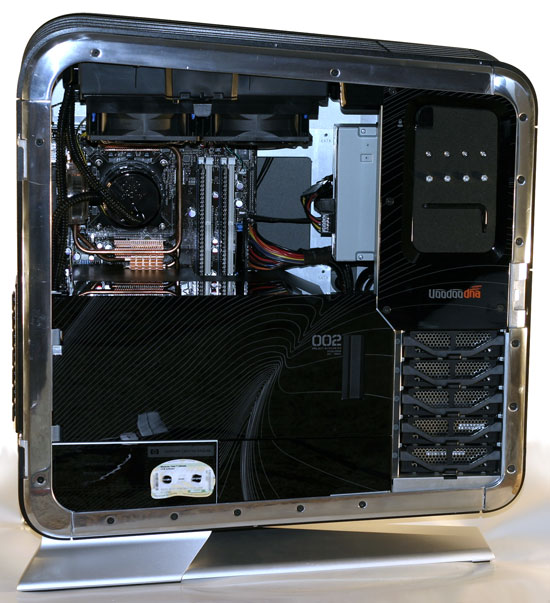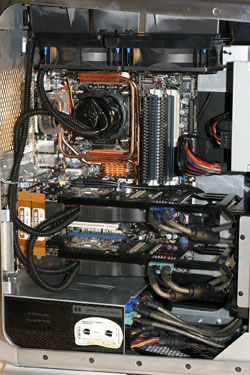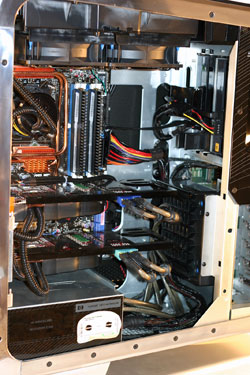Blackbird 002, Take Two
One of the most impressive aspects about the Blackbird is undoubtedly the case design. This isn't just your typical rectangular computer case with a window, some lights, a design cut into the metal, and a fancy paint job. As we mentioned in the previous article, the fully assembled case is quite heavy, but it's also extremely sturdy. The case is made from cast aluminum, and the main structure is extremely thick aluminum. The system we were shipped weighs about 70 pounds, and while the liquid cooling certainly accounts for some of the weight, the thick shell is the primary contributor.
One of the aspects of the case that we didn't mention previously (in part because we weren't aware of this fact at the time) is that the case door can actually be easily removed. Swing the door open and lift up on it and you can pull it off the pins and set it aside while you access the internals. Because of the heavy-duty design, this can all be accomplished without compromising structural integrity.
Other than looking cool and weighing a lot, the design of the case does serve other purposes. First, the raised chassis opens up a sixth side of cooling: air can now come in the bottom of the case. This may not be strictly necessary, but with the compartmental design that HP has created the bottom intake provides fresh air to the power supply.
The purpose of the compartmentalized design is to provide optimal cooling to all of the major components without creating a bunch of turbulence, so the internals are broken up into three main sections: at the bottom is the power supply, in the middle are the expansion cards, and at the top we find the CPU and water cooling system. The hard drives are located towards the front of the chassis and cooled by an internal 120mm fan that also provides airflow to the expansion cards. Having this fan located several inches inside the chassis allows it to provide airflow without generating much in the way of audible noise.
The panel that holds the expansion cards in place swings open with a quick release of the latch, and like the main door this can also be removed. Other plastic panels that help divide the interior into compartments can also be removed, and with all of these out of the way users get quick and easy access to the internals.
Upgrading expansion cards - outside of dealing with the water cooling on the GPU(s) if you get the LCi version - adding or removing hard drives, or swapping out the secondary optical drive can all be done in a matter of minutes without ever needing to touch a tool. We've seen plenty of tool-less case designs over the years, but without a doubt this is one of the slickest approaches that we've ever had the pleasure of using. It's also important to remember that even with the unique case construction, all the components contained within the Blackbird are all standard ATX offerings.
All of this raises some interesting points of discussion in regards to the case. Assuming that the cumbersome weight isn't a problem - it will be for some people but not for others - how much are we actually talking about spending on just the case? A lot of people are perfectly happy with the typical Antec and Cooler Master budget cases, but some people want a truly high-quality case like a Lian Li and they're willing to spend several hundred dollars if necessary. Will it be possible for users to simply bypass HP and purchase the case separately? (For now, the answer is no, but if enough people are interested HP might have a change of heart.) If you're looking at building a completely new high-end computer anyway, however, that might not even be necessary provided that HP's prices are reasonable. So how does HP's pricing of the Blackbird compare with a DIY build?
One of the most impressive aspects about the Blackbird is undoubtedly the case design. This isn't just your typical rectangular computer case with a window, some lights, a design cut into the metal, and a fancy paint job. As we mentioned in the previous article, the fully assembled case is quite heavy, but it's also extremely sturdy. The case is made from cast aluminum, and the main structure is extremely thick aluminum. The system we were shipped weighs about 70 pounds, and while the liquid cooling certainly accounts for some of the weight, the thick shell is the primary contributor.
 |
One of the aspects of the case that we didn't mention previously (in part because we weren't aware of this fact at the time) is that the case door can actually be easily removed. Swing the door open and lift up on it and you can pull it off the pins and set it aside while you access the internals. Because of the heavy-duty design, this can all be accomplished without compromising structural integrity.
Other than looking cool and weighing a lot, the design of the case does serve other purposes. First, the raised chassis opens up a sixth side of cooling: air can now come in the bottom of the case. This may not be strictly necessary, but with the compartmental design that HP has created the bottom intake provides fresh air to the power supply.
 |
The purpose of the compartmentalized design is to provide optimal cooling to all of the major components without creating a bunch of turbulence, so the internals are broken up into three main sections: at the bottom is the power supply, in the middle are the expansion cards, and at the top we find the CPU and water cooling system. The hard drives are located towards the front of the chassis and cooled by an internal 120mm fan that also provides airflow to the expansion cards. Having this fan located several inches inside the chassis allows it to provide airflow without generating much in the way of audible noise.
 |
 |
The panel that holds the expansion cards in place swings open with a quick release of the latch, and like the main door this can also be removed. Other plastic panels that help divide the interior into compartments can also be removed, and with all of these out of the way users get quick and easy access to the internals.
Upgrading expansion cards - outside of dealing with the water cooling on the GPU(s) if you get the LCi version - adding or removing hard drives, or swapping out the secondary optical drive can all be done in a matter of minutes without ever needing to touch a tool. We've seen plenty of tool-less case designs over the years, but without a doubt this is one of the slickest approaches that we've ever had the pleasure of using. It's also important to remember that even with the unique case construction, all the components contained within the Blackbird are all standard ATX offerings.
All of this raises some interesting points of discussion in regards to the case. Assuming that the cumbersome weight isn't a problem - it will be for some people but not for others - how much are we actually talking about spending on just the case? A lot of people are perfectly happy with the typical Antec and Cooler Master budget cases, but some people want a truly high-quality case like a Lian Li and they're willing to spend several hundred dollars if necessary. Will it be possible for users to simply bypass HP and purchase the case separately? (For now, the answer is no, but if enough people are interested HP might have a change of heart.) If you're looking at building a completely new high-end computer anyway, however, that might not even be necessary provided that HP's prices are reasonable. So how does HP's pricing of the Blackbird compare with a DIY build?










33 Comments
View All Comments
georgemag07 - Saturday, October 20, 2007 - link
I spent some time with the Blackbird at the E4All Expo in Los Angeles. Here are some pictures I took to round out the article. I was inpmressed by the design and the eSATA ports that are standard with the Machine.http://www.flickr.com/photos/8184625@N08/tags/blac...">http://www.flickr.com/photos/8184625@N08/tags/blac...
newhit - Thursday, October 4, 2007 - link
I've already got a Blackbird. Where does the Exhaust go on this one. Twin Akropovich straight thru pipes should realease a few extra BHP. This ones not good for pillions though.nets - Thursday, October 4, 2007 - link
I might be nitpicking but I think your prices are a bit low. HP told me they use EVGA cards and I can't find any under $630But your biggest mistaske was forgetting to add the price of the case. Your parts came to $4,102 + $300 for the case is $4,402
You said:
"All told, it appears that the case, CPU overclocking, and system assembly carries a charge of around $1400 on the Dedication Edition."
So -with- case the extra charge is $1,100 - or with prices I found at newegg closer to $1,000
I say that ain't bad.
nets - Thursday, October 4, 2007 - link
I just re-read your article and you considered the case IN the overcharge. I understand your point now. Still, if you assume a $300 case the overcharge for the COMPLETED machine is indeed $1,100JarredWalton - Thursday, October 4, 2007 - link
$300 might also be a bit low for this case - I'd consider it "better" than something like a Silverstone in a lot of ways, so we could probably even go so far as to say it's a $400 or even $500 case. That's the price you pay for getting something "exotic", right?As for the 8800 Ultra, you're right that HP uses EVGA on their 8800 Ultra GPUs. Unless they're getting factory OC'ed models, though, there's no real difference between EVGA stock 8800 Ultra and "Brand-X" 8800 Ultra. They all use reference designs for cooling, RAM, PCB, etc., and since HP puts on water cooling (at least at the LCi/Dedication) the stock board seems to have even less meaning.
That said, I know I saw a $590 Ultra when I put together the original price list, but the cheapest I'm seeing now is $610 (XFX). Since prices will fluctuate over time, I'll bump the price up a bit but over time the tables will undoubtedly be outdated.
nets - Thursday, October 4, 2007 - link
I asked HP if they overclocked the GPUs and they said "they already come overclocked so we didn't mess with them."I think a $1,000 charge for what is essentially a boutique PC is a bargin (compared to Falcon, Maingear, etc.! From your review I think you agree.
JarredWalton - Thursday, October 4, 2007 - link
Definitely. As I tried to make clear, *IF* you're in the market for an "exotic" high-end PC, the Blackbird is a real bargain compared to most other offerings. Alienware is about $500 more at least - and personally I'm not a huge fan of the "Alien Head Case" design. Falcon is about $2500 more and VoodooPC is about $3000 more. But you do get additional attention to detail with the latter two companies (and I'm sure some others that I failed to mention).I have no idea which EVGA GPUs are used, as I have/had (FedEx is coming today... sigh) the CrossFire version. It will be interesting to see what the Blackbird comes with in early 2008 as well, as I expect quite a few upgrades to appear. Penryn/Phenom, X38 (or some other chipset), and new GPUs are all coming out soon.
nets - Thursday, October 4, 2007 - link
I certainly agree about Alienware, I have always hated that case.EateryOfPiza - Tuesday, October 2, 2007 - link
Anandtech should compare the Blackbird to a comparably equipped build-your-own system, with parts matching as much as possible to see how much the custom case, the professional wiring, and other junk VoodooPC and other high end PC OEMs like Alienware really add to the price.nets - Thursday, October 4, 2007 - link
The price for your excellent budget system was $3,125 but you want HP to get the Blackbird under $1,500?That sounds unrealistic.